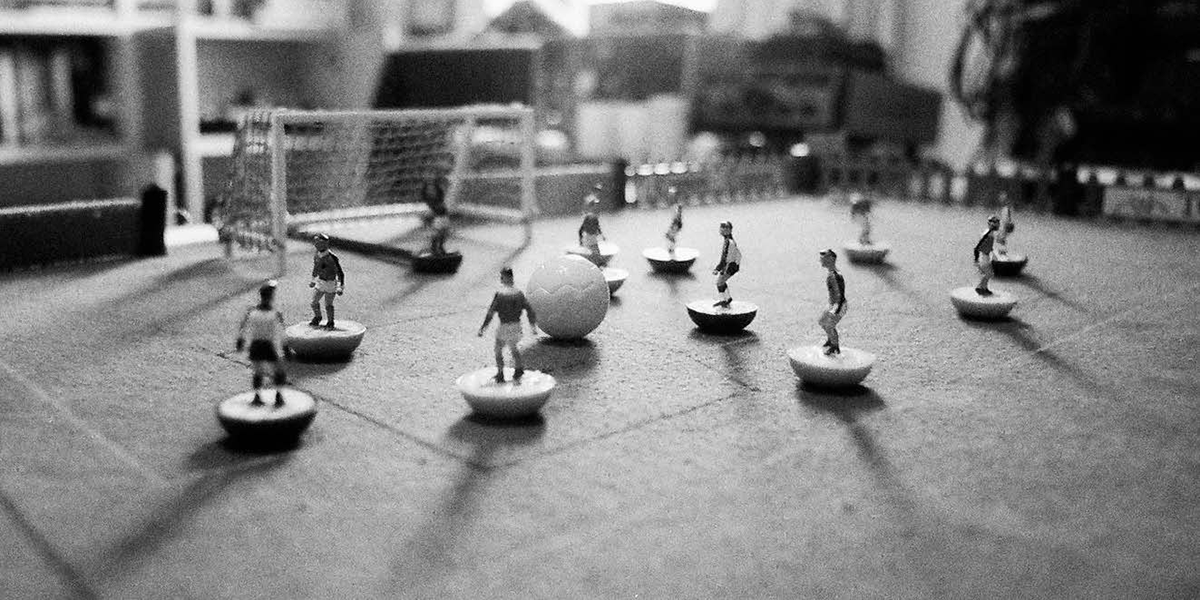Origins and Humble Beginnings
Subbuteo is a tabletop football game in which players flick miniature figures to play out matches of soccer. It was invented in 1946 by an Englishman, Peter Adolph, who had just been demobilized from the Royal Air Force after World War IIen.wikipedia.org. Adolph was seeking a new business venture in post-war Britain and, inspired by a pre-war game called “Newfooty,” set out to create an improved table soccer experienceen.wikipedia.orgfourfourtwo.com. Using a button from his mother’s coat and a washer as a prototype base, he experimented with lightweight materials to replace the heavy lead figures of earlier gamesen.wikipedia.org. In August 1946 he filed a patent for his game, initially calling it simply “Table Soccer,” and began gauging interest via advertisements in The Boy’s Own Paperen.wikipedia.org. The response was overwhelming – orders poured in even before the product was ready, prompting Adolph to rush his idea into a deliverable form by early 1947en.wikipedia.org.
Adolph’s fledgling game needed a unique name. His first choice – “Hobby,” reflecting both a pastime and the hobby falcon – was denied as a trademark. In a creative twist, he turned to the bird’s scientific name Falco subbuteo (the Eurasian hobby hawk) and coined “Subbuteo” as the brand nametheguardian.com. The very first Subbuteo kits reached customers in March 1947 and were decidedly humble. Sold as Assembly Outfits, they included goals made of bent wire with paper nets, a small flickable ball made of cellulose acetate, and teams of flat cardboard players printed in two colors (red/white and blue/white kits)en.wikipedia.org. No physical game board was provided, instead, buyers received chalk and instructions to mark out a pitch on any blanket (an old green army blanket was recommended as an ideal “field”)en.wikipedia.org. The cardboard players came in strips one had to cut or press out and mount on buttons weighted with lead washers (Adolph famously scavenged Woolworth’s buttons after using his mother’s button for the prototype)en.wikipedia.org. Despite these rudimentary beginnings, the concept captured the imagination of children and football-loving families in Britain. By the late 1940s, Subbuteo, initially advertised as “the new game of table soccer”, was finding a small but growing customer base, laying the groundwork for a tabletop legend.
Rise to Popularity and Golden Era
In the 1950s and 1960s, Subbuteo grew from a niche mail-order novelty into a worldwide phenomenon. Adolph continually refined the product: the paper cutouts evolved into two-dimensional celluloid figures (known to collectors as “flats”) and eventually into molded three-dimensional figures by the early 1960sfourfourtwo.comfourfourtwo.com. This leap to 3D miniatures – marketed as the “Continental” range, proved to be a masterstroke that kicked off Subbuteo’s golden era. Although producing hand-painted figurines was labor-intensive, Subbuteo built an army of home-based painters (at one point “about half the mums in Kent” were earning pocket money painting tiny footballers, according to a former salesman)fourfourtwo.comfourfourtwo.com. The result was a far more realistic and appealing product. Subbuteo’s little men now looked like actual footballers, each perched on a rounded base that allowed them to glide over the cloth pitch when flicked.
By the mid-1960s, the game’s popularity was surging. Adolph’s timing coincided with a boom in football’s cultural significance, England hosted (and won) the 1966 FIFA World Cup, and Subbuteo capitalized on the moment. In 1966 the company aired its first ever TV commercial, bringing flick-to-kick football into living rooms just as millions of youths were football-madfourfourtwo.com. Marketing efforts also included offering a vast array of team kits and accessories. Subbuteo produced hundreds of team sets mirroring real club and national team colors, so that fans could own a miniature version of, say, Brazil’s famous yellow shirts or Manchester United’s red kitsen.wikipedia.org. By the late 60s, the product line had expanded to include grandstand sections, floodlights, scoreboards, referee and streaker figures – all the trappings of real football matches, enhancing the immersive experience for playersfourfourtwo.comfourfourtwo.com. There were even special editions beyond football: Subbuteo introduced spin-off versions for cricket, rugby, and hockey to broaden its appeal across sportsen.wikipedia.orgtheguardian.com.
This period also saw Subbuteo cement itself in the broader culture. The miniatures were so ubiquitous that legendary Liverpool manager Bill Shankly famously used a Subbuteo set to demonstrate tactics, flicking opposing players off the board for dramatic effect when rousing his teamfourfourtwo.com. Pop culture references abounded; notably, in 1980 the punk-rock band The Undertones scored a hit with “My Perfect Cousin,” which featured the lyric “he always beat me at Subbuteo” and even depicted a Subbuteo figure on the single’s cover artfourfourtwo.com. Such was the game’s reach that by the 1970s, Subbuteo wasn’t just a toy, it was a household name in the UK and had spread to Europe, South America, and beyond. The company’s success attracted corporate attention: in 1969, the board game giant Waddingtons (known for Monopoly and Cluedo) offered to buy out Subbuteo. Adolph sold the brand for a reported £250,000 (equivalent to about £4 million today)fourfourtwo.com, and although he stayed on as a consultant for a time, the game was now in the hands of a larger company poised to scale it globally.
Peak popularity for Subbuteo is generally considered to be the 1970s and early 1980s, when the game was truly international. During this era Subbuteo sets were a common sight at Christmas for many children, and organized play was growing (school and community leagues sprouted in many countries, feeding into national championships). A 1988 BBC report estimated that Subbuteo had 5 million players in more than 50 countries, underlining the worldwide penetration of the gamefriendsofoldsubbuteo.uk. The brand continued to innovate to maintain its appeal, or example, responding to real-world concerns about football hooliganism, the 1980s Subbuteo catalog introduced miniature crowd barriers, police, and ambulances to reflect the modern stadium atmospheretheguardian.com. From local family gatherings to serious club tournaments, Subbuteo had become woven into the fabric of football fandom. The sight of the green cloth pitch and the sound of a plastic football rattling the tin goal were instantly nostalgic for a generation, symbolizing a “beautiful game” that one could play on the living room table.
Decline and Fall from Prominence
Subbuteo’s reign atop the tabletop sports world, however, began to wane in the late 1980s and 1990s. Several factors contributed to its decline in popularity. A major challenge came from the rise of electronic entertainment, the late ’70s and onward saw the advent of affordable video game consoles, home computers, and VCRs, offering new forms of interactive play. Children increasingly turned to video soccer games and other digital pastimes, leaving flick-to-kick football less fashionable by comparisonfourfourtwo.com. Subbuteo tried to modernize its product and production methods but met mixed results. In 1978, the company introduced a new one-piece plastic figure (nicknamed the “zombie” figure by fans) that could be machine-painted to reduce labor costs. This figure was sturdier but more stiff-looking, and it received negative feedback from longtime fans who preferred the classic hand-painted players with personalityen.wikipedia.org. By 1980 the unpopular zombie style was replaced by a lighter, more flexible figure, but the damage in perception may have already been doneen.wikipedia.org.
Ownership changes also played a role in Subbuteo’s fall. In the early 1990s, Hasbro Inc. , an American toy giant, acquired Waddingtons Games (and with it, Subbuteo)en.wikipedia.org. Under Hasbro, Subbuteo was not a core product, and marketing support waned just as competition from video games (like the FIFA console series) grew fiercer. The effect on sales was dramatic: Subbuteo went from selling roughly 150,000 sets per year in the early 1990s to only about 3,000 sets by 2002en.wikipedia.org. By 2003, facing such diminished demand, Hasbro halted production entirelyen.wikipedia.org. For a time, the beloved game vanished from toy store shelves. Brief resurgences were attempted, Hasbro tried re-launching Subbuteo in 2005 with a modern twist (using flat, photorealistic card figures instead of 3D miniatures), but this reboot flopped and was quickly discontinueden.wikipedia.org. A later revival in 2012, handled by a licensee (Eleven Force of Spain), brought back the classic three-dimensional rubber figures and reintroduced Subbuteo to certain marketsen.wikipedia.org. While this revival catered to nostalgia and kept Subbuteo in production into the 2010s, it remained a niche success, largely limited to collectors and enthusiast circles.
Ultimately, the decline of Subbuteo from its peak can be attributed to changing play habits and fierce competition from electronic gaming, compounded by corporate decisions that sometimes alienated the fan base. By the early 2000s, the tabletop soccer icon that once loomed large in youth culture had lost its mass-market presence. The brand persisted under Hasbro’s ownership in a diminished capacity, a registered trademark kept alive through occasional product releases and fan demanden.wikipedia.orgen.wikipedia.org, but Subbuteo was no longer the ubiquitous fixture it had been. It survived as a cherished retro game, fondly remembered by those who grew up flicking its tiny footballers, even as newer generations gravitated to digital soccer experiences.
Tournaments and Championship Events
One of the enduring legacies of Subbuteo is the competitive scene it spawned. As early as the 1960s, passionate players were forming clubs and organizing tournaments, which eventually led to formal championship events at national and international levels. The first Subbuteo World Cup tournament took place in 1970, hosted in London, Englanden.wikipedia.org. This inaugural event marked the beginning of a tradition: Subbuteo “World Cups” were held roughly every four years in the early days, often mirroring the excitement of real FIFA World Cups (for example, the 1974 Subbuteo World Cup was in Munich, the same year West Germany hosted and won the FIFA World Cup)en.wikipedia.org. In these competitions, players (typically national champions) would represent their countries, and early Subbuteo powers included West Germany, England, and Belgium, who all took titles in the 1970s and ’80sen.wikipedia.org. Over time, the competitive circuit grew more structured. A European governing body, the European Table Soccer Federation (ETF), had been established in 1963, and by 1979 an international federation called FISA (Federation of International Subbuteo Associations) was coordinating worldwide eventsen.wikipedia.org. These organizations eventually merged and evolved into the modern governing body for the sport: the Federation of International Sports Table Football (FISTF), founded in 1992 in Hamburgen.wikipedia.org. Under FISTF, Subbuteo (often dubbed “sports table football”) continues to have standardized rules and an organized tournament circuit.
Throughout the late 20th century, Subbuteo championships drew a dedicated following. Annual national championships were held in many countries, producing elite players who would compete in European and World Cup tournaments. Notably, Italy emerged as a dominant force in competitive Subbuteo from the 1990s onward – Italian players or teams have won numerous world titles, reflecting the game’s strong popularity in Italyen.wikipedia.orgen.wikipedia.org. Belgium, too, has produced top champions, as evidenced by multiple World Cup wins and finals appearances by Belgian players over the yearsen.wikipedia.orgen.wikipedia.org. Matches at this level are fiercely contested and surprisingly technical; players train to perfect flicking techniques with precision and strategy comparable to chess or billiards. Over the decades, there have even been colourful tales of competitive gamesmanship – a BBC tongue-in-cheek investigation in 1988 reported incidents of players doctoring figures with extra weights or slicking bases with polish to gain an edge, and even a case of rival fans “kidnapping” a Subbuteo goalkeeper during a European championship matchfriendsofoldsubbuteo.ukfriendsofoldsubbuteo.uk. These stories, whether apocryphal or real, highlight the intense devotion found in the Subbuteo tournament scene.
Organizers have kept the spirit alive by hosting international events even into the 21st century. World Cup tournaments are still held under FISTF’s auspices, featuring categories for individuals, club teams, juniors, and veterans. In a full-circle moment, the 2024 Subbuteo World Cup was hosted in Royal Tunbridge Wells – the birthplace of Subbuteo – as a celebration of the game’s heritage in its eighth decadeen.wikipedia.org. That event brought together competitors from around the globe, underscoring that while Subbuteo’s mass-market heyday has passed, its competitive community remains vibrant. From 1970 to today, these championship gatherings have served as both high-level sporting contests and reunions for the Subbuteo faithful, ensuring that the flick-to-kick game endures as an organized sport in its own right.
Fan Communities, Collectors, and Clubs
Even as mainstream popularity declined, Subbuteo has been sustained by dedicated fan communities and collectors who never lost their passion for the game. Across the decades, enthusiasts formed local clubs and leagues to play regularly. In the 1970s and ’80s, many towns (especially in the UK and Italy) had Subbuteo leagues where players would meet in community halls or pubs to compete in mini-tournaments. These grassroots activities often fed into larger regional or national competitions, creating a social network around the game. With the advent of the internet, the community became even more interconnected. Fans established online forums and blogs to discuss team collectibles, share tips on painting custom figures, and arrange matches. For instance, the blog Subbuteo Online (run by enthusiast Stephen Hurrell) offers news and nostalgia, reflecting the ongoing interest in all things Subbuteofourfourtwo.com. There are also forums like the Subbuteo Players Forum, where devotees from different countries chat about rules, new figure products, or how to restore vintage sets.
One significant aspect of the fan community is collecting. Subbuteo produced literally hundreds of different team sets and accessories over the years, and these have become prized collectibles. Devoted collectors hunt for rare team editions, limited-run accessories, or early-edition box sets. Some items – like a 1960s-era team in an unusual kit, or the infamous 1978 “zombie” figures in mint condition – can fetch high prices in collector circles. Swap meets and collector fairs have been a staple of the community. For example, the North of England Subbuteo Collectors’ Fair in Yorkshire attracts hundreds of collectors and dealers from around the world, trading everything from 1940s cardboard figures to the latest rebooted teamstheguardian.com. At such fairs, it’s not uncommon to find a very early Subbuteo set on display – perhaps with its wire goals, cloth pitch and vintage packaging, drawing admiration from those who remember playing with identical sets in their youththeguardian.com. Enthusiasts also preserve and catalog the history: websites like Friends of Old Subbuteo document the game’s lore, and fan magazines (fanzines) have existed since the 1970s. In fact, during Subbuteo’s heyday, a collectors’ magazine humorously titled “Flick Me Sideways” was circulated, and today its tradition is carried on by online newsletters and community-driven publicationsfourfourtwo.com.
Local Subbuteo clubs and national associations further keep the flame alive. Many countries still have active clubs where members meet to play competitive or friendly matches on a regular schedule. In Italy, for instance, there are club teams that contest a league under FISTF, and in the UK there are community clubs that have been running for decades. These clubs often welcome newcomers, ensuring that knowledge of the game, from flicking techniques to the careful ironing of the felt pitch, is passed down. The camaraderie in the Subbuteo scene is strong: what began as a schoolboy pastime has evolved into a tight-knit international fraternity (and sorority, there are female players and collectors as well) bound by shared nostalgia and love of the game. The enduring fan activities around Subbuteo – be it collecting, club play, or online discussion – demonstrate that while the brand’s commercial peak has passed, its cultural and emotional impact endures. In the words of many fans, Subbuteo never really “died”; it simply moved from the toy shop to the community halls and forums where its legacy is lovingly preserved.
Digital Adaptations and Modern Reboots
In addition to in-person play, Subbuteo has also made the jump into the digital realm through various adaptations – both official and fan-made. The idea of translating flick-to-kick gameplay to a video game emerged as early as the late 1980s, and in 1990 an official Subbuteo computer game was released by Goliath Games for a range of platforms including Amiga, Atari ST, Commodore 64, Amstrad CPC, ZX Spectrum, and MS-DOS PCsen.wikipedia.org. This 1990 title faithfully tried to recreate the Subbuteo experience on screen: it was essentially a turn-based digital simulation of table football, where players had 30 seconds per move to aim a flick and could even apply curve or “swerve” to the ballarchive.orgarchive.org. The effort was well-received in the gaming press – CU Amiga Magazine gave it a glowing 95% rating, praising that the developers “managed to distill the essential elements of the original game and transfer them” to the digital formaten.wikipedia.org. For fans who couldn’t always find a human opponent or set up a physical pitch, this video game offered a new way to enjoy Subbuteo’s tactical flicking fun.
Over the years, a few other official attempts were made to modernize Subbuteo via video games and apps, though none achieved blockbuster success. Hasbro’s 2005 reboot with flat figurines did not extend to a full video game adaptation, but in the 2010s the Subbuteo brand popped up in mobile gaming. An officially licensed mobile game titled Subbuteo was released around 2012–2013 for smartphones, attempting to combine the classic gameplay with modern touch controls (though it garnered only modest attention). More influential have been the unofficial digital adaptations created or embraced by the Subbuteo community. For example, mobile apps like Slide Soccer and Soccer Stars have become popular among Subbuteo enthusiasts for their remarkably similar mechanics. These games use disc-shaped players and flick-to-shoot controls that closely mirror the Subbuteo style, effectively bringing the tabletop game to phones and tablets. One Subbuteo Players Forum review lauded Slide Soccer as “one of the closest experiences you can get to tabletop Subbuteo on the mobile platform,” noting its enjoyable flick-based physics and even features like different pitch surfaces and multiplayer modessubbuteoplayersforum.co.uksubbuteoplayersforum.co.uk. Millions of downloads of such apps have introduced the essence of Subbuteo to a new generation in a digital form, even if the Subbuteo name itself isn’t always on the title.
Beyond standalone games, fans have also implemented Subbuteo in virtual sandbox environments, for instance, using Tabletop Simulator on PC to set up and play Subbuteo matches online with others, complete with custom 3D models of the players. And while no major console video game version of Subbuteo has emerged, the continued nostalgia for the brand leaves the door open. As of 2025, there are indications that independent developers (often themselves longtime Subbuteo players) are working on new digital versions, hoping to capture that unique blend of strategy and skill for modern gaming platforms. In summary, Subbuteo’s digital legacy is a modest but meaningful one: an official 1990 game that proved the concept could work on-screen, followed by community-driven adaptations that keep the flicking spirit alive in cyberspace. These digital forays, coupled with the physical game’s devoted fan base, ensure that Subbuteo’s motto of “flick to kick” continues to echo, whether on a cloth pitch or a touchscreen, well into the 21st century.
Sources:
-
Subbuteo name origin and inventor – The Guardian (Sport Gallery)theguardian.com; Wikipediaen.wikipedia.orgen.wikipedia.org
-
Early Subbuteo sets and concept – Wikipedia (Subbuteo History)en.wikipedia.orgen.wikipedia.org
-
Golden era, 3D figures and 1960s boom – FourFourTwo (Gary Parkinson, Aug 2021)fourfourtwo.comfourfourtwo.com; Wikipediaen.wikipedia.org
-
Marketing, cultural impact – FourFourTwofourfourtwo.com; Guardian (in pictures)theguardian.comtheguardian.com; Friends of Old Subbuteofriendsofoldsubbuteo.uk
-
Decline factors (video games, sales drop, Hasbro) – FourFourTwofourfourtwo.com; The Independent (via Wikipedia)en.wikipedia.org; Wikipedia (relaunch attempts)en.wikipedia.org
-
Tournaments and federations – Wikipedia (Subbuteo World Cup, FISTF)en.wikipedia.orgen.wikipedia.org; Friends of Old Subbuteo (BBC report)friendsofoldsubbuteo.uk
-
Fan community and collecting – The Guardian (Collectors’ Fair)theguardian.com; FourFourTwofourfourtwo.com; Subbuteo Players Forumsubbuteoplayersforum.co.uk
-
Digital adaptations – Wikipedia (Video game)en.wikipedia.org; Subbuteo Players Forum (Slide Soccer review)subbuteoplayersforum.co.uksubbuteoplayersforum.co.uk
Thank You For Coming To www.funatic.games
Please Follow Us On Social Media
Contact Us, We'd Love To Hear From You
Click HERE To Learn More About Funatic Games
Click HERE To Learn More About Nova Terra
Click HERE To Learn More About FlicKick Table Soccer









